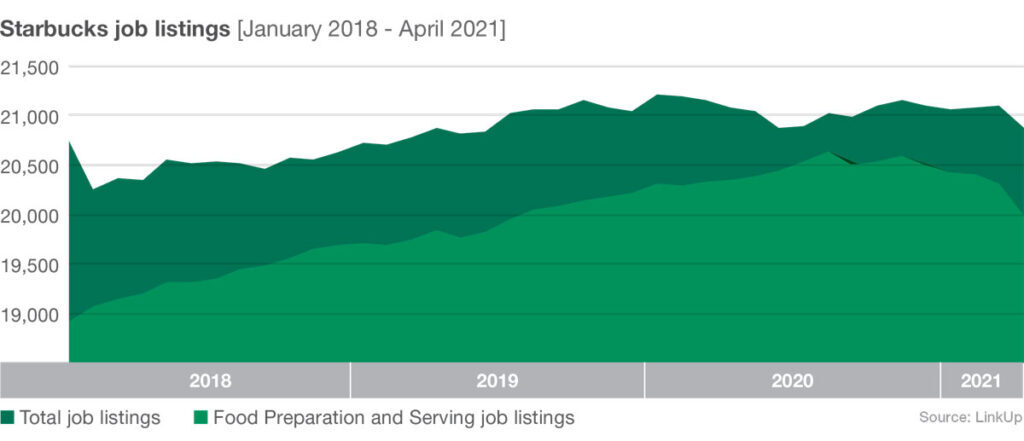Tracking Starbucks jobs as coffee sales cool
Believe it or not, fewer people drank coffee in the United States during the pandemic compared to levels seen before it, according to a survey by the National Coffee Association (NCA).

When little else is certain, there is always coffee. The beverage remains the undisputed favorite in the U.S., with Americans consuming 400 million cups per day. But believe it or not, fewer people drank coffee in the United States during the pandemic compared to levels seen before it, according to a survey by the National Coffee Association (NCA).
The NCA found that 58% of people in the U.S. had at least one coffee the day before responding to the survey in January 2021, as opposed to the 62% who had a year earlier. The survey also found that morning coffee drinking habits have remained relatively unchanged, however afternoon coffee drinking has dropped 4 percentage points–a drop resulting from fewer people making visits to coffee shops.
You can see this change in consumer behavior playing out in revenue for the segment. Project Café USA 2021 shows the $36 billion market suffered an $11.5 billion sales decline over the last year with the total number of outlets contracting 0.6%. But the U.S. market continues to prove its innovative potential, adapting to COVID constraints with expanded drive-through capabilities, digital integration and new trading formats.
Starbucks in particular captured our attention–it stood out as a company with high job counts in food service occupations, and with constant job growth throughout the pandemic in those occupations. Job listings for baristas make up 96% of Starbucks current openings.
The demand for baristas at Starbucks has been growing steadily since 2018. In the last month, however, it seems the hot streak has started to cool down. Starbucks’ jobs began to see a drop starting on March 1st, and have decreased 1% since, driven largely by the 2% decrease in barista jobs
The Seattle-based coffee mega-chain actually celebrated their 50th anniversary during the pandemic, their first store opened in Pike Place Market on March 30th, 1971. They certainly felt the sting of the pandemic’s impact on coffee sales–Starbucks’ Q4 results showed same-store sales down about 5% in the U.S. With commutes disrupted and few gathering in once bustling urban centers, Starbucks closed hundreds of urban stores last year, though it plans to open just as many drive-thrus and pickup stores in suburban locations.
For a company with a strong history of innovation and early adoption of omnichannel technology, the pandemic has challenged Starbucks to think about the future of food service and how best to meet customers where they are now, and where they will be. From that perspective it seems likely that the dip in job listings is, in all likelihood, a temporary drop while business strategies shift. We will continue to monitor jobs numbers for the company (as well as early speculation as to when they’ll kick off pumpkin spice season this year) to see whether hiring picks up.
Insights: Related insights and resources
-
Blog
03.08.2023
Strong Job Gains in February, Despite Declining Labor Demand, Will Likely Add More Confusion to the Already-Confounding Macro Environment
Read full article -
Blog
02.04.2022
Data shows continued tight labor market in the U.S.
Read full article -
Blog
02.12.2020
Forecasting JOLTS Data with LinkUp's Jobs Data
Read full article
Stay Informed: Get monthly job market insights delivered right to your inbox.
Thank you for your message!
The LinkUp team will be in touch shortly.


